9 Ways to Enforce Data Quality in B2B Sales and Marketing
This article is for revenue leaders and RevOps people who are frustrated with the inability to get...

Voice of Prospect (VoP) data is information sourced from capturing, structuring, and analyzing what your prospects say on recorded sales calls.
And the world is just beginning to understand the power of exploiting VoP.
“More than 70 percent of B2B buyers fully define their needs before engaging with a sales representative, and almost half identify specific solutions before reaching out,” according to a new report from CSO Insights.
Because a significant part of the buying journey is completed before companies even begin talking to their prospects, companies have lost touch and have an arm’s length understanding of their buyers.
Technology buyers no longer view interactions with sales people as their best source for information about an industry, product, or service.
Until 2020, companies with inside sales teams were particularly susceptible to losing touch.
Then, the COVID-19 pandemic exacerbated these dynamics between buyers and sellers...for everyone.
Field sales people who previously met with, entertained, and pitched prospects in person were completely grounded as work went remote.
This massive shift that affected every sales person at every company created an incredible opportunity for companies to gather MORE data about their buyers than ever before.
Now, nearly every intro meeting, demo, and proposal call takes place on Zoom, WebEx, or Go-to-Meeting, giving your sales team the capability to record these conversations so that everything your prospects say can be captured and analyzed.
The difference between VoP and VoC is straightforward.
Voice of Prospect data is sourced from what your prospects say during the new customer acquisition process.
People who are considering your product or service will share the following:
The more commonly known Voice of Customer data is sourced from existing customers. People who are already your customers will give you feedback about:
Both VoP and VoC data are essential to building a successful business. If you’re interested in learning more about VoC, I recommend you check out these resources by Gainsight, Hubspot, and Qualtrics.
Since scaleMatters is focused on surfacing data and insights to drive new customer acquisition, the balance of this article will focus on Voice of Prospect Data.
Successful marketing and sales requires intimately understanding your buyers so you can deliver the right message and position your product in the right market.
Get it right and you’ll grow like crazy.
Miss the mark and you’ll likely struggle with low website conversion rates, long sales cycles, and low win rates.
Historically, product marketers have taken the lead in gathering prospect feedback through eight main avenues. Each one has drawbacks:
| Old Method for Capturing Voice of Prospect | Drawback to this method |
| Buyer persona interviews | For a typical marketing team, persona research can be done at best once every year or two. Excellent feedback can be gleaned but it’s usually your existing customers who are willing to help, not potential customers. |
| Reading customer reviews online | Customer reviews primarily reference your product/service, and are by definition not prospect reviews. |
| Copying competitors | Taking inspiration from competitors is helpful, but it’s unlikely they have a systematic, measurable approach to capturing VoP. |
| Talking to frontline customer support and client success people | These folks are talking to people who already decided to buy your product, and don’t usually provide great presale insights. |
| Talking to frontline sales people | Getting subjective feedback from people that talk directly to prospects all the time is helpful, but it’s biased and often anecdotal feedback at best. |
| Pop-up surveys / feedback forms | Tools like HotJar let marketers gather feedback from website visitors about how specific pages resonate, but it’s limited. |
| Third Party Research | When branding agencies or analysts interview buyers in your industry, their reports are helpful, but they’re static and don’t precisely reflect a buyer’s mindset and emotions as they truly enter a buying cycle. |
Gong.io is the #1 ranked software in the world based on G2 customer reviews. Dubbed ‘conversation intelligence software’ or ‘revenue intelligence software’, Gong.io primarily focuses on equipping sales managers with dynamic tools to listen to recorded calls, coach their team members, track their deals and interactions, and much more.
There’s an additional use case for Gong.io that is more strategically powerful: Capturing and structuring Voice of Prospect data.
By leveraging conversation intelligence software, you get the most natural, stream of consciousness feedback directly from your buyers.
No more depending on salespeople to provide secondhand feedback on what prospects say or to enter accurate buyer data into the CRM.
For Gong.io to work, it must be configured to record virtual sales meetings and calls. This involves setting up Gong with your calendar/email tool (e.g. Google), meeting software (e.g. Zoom) and/or sales acceleration software (e.g.. Salesloft), and your CRM (e.g.. Salesforce CRM).
Quick tip: Establish a consistent naming convention that your sales team can follow when they send calendar invites to prospects so it’s easy to sort and find similar calls in Gong. For example, each intro call should be labeled “[Company] Intro to [Prospect].”
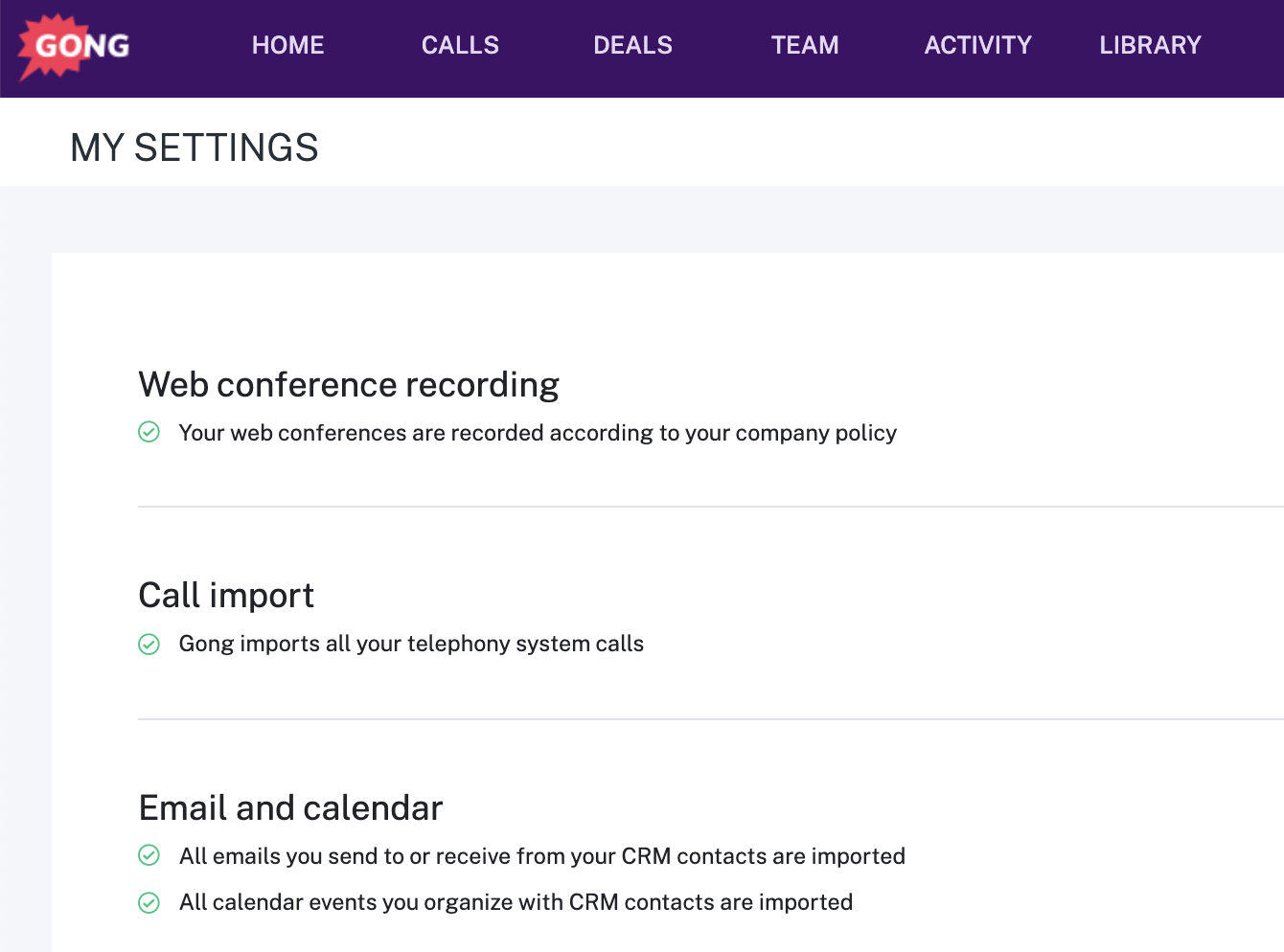
After connecting Gong to your meeting software to record your sales calls, you’ll want to create specific call categories so you can aggregate calls where the MOST prospect feedback will likely be gathered.
For most businesses, these include intro calls, qualification calls, demos, or proposal calls hosted by your salespeople. In this example below, I’ve set up a category for “Demo” calls that are over 20 minutes long.
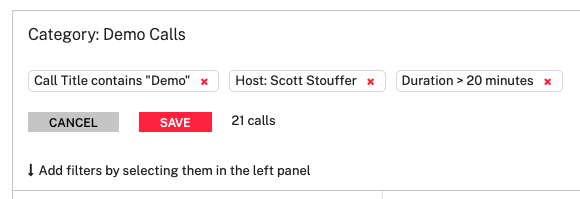
The Tracker feature in Gong allows users to set up a filter that captures every time a prospect says a certain word or phrase. Trackers are highly flexible and can be used to capture very broad topics or very specific topics.
In the example screenshot, I have set up a Tracker to capture when a prospect mentions that they are currently using the software company, Clari. Gong will log this tracker and I can then easily search, find, and report on any calls where a prospect mentions the company, “Clari”.
![]()
Want to know how often your prospects are saying key words or phrases? You can spot trends by reporting on the volume of times a Tracker is tagged, the percentage of total calls that Trackers are tagged, and how that Tracker presence has grown or decreased over time. Where else can you get this granular?
![]()
If you want to listen to calls, you can sort by specific trackers or call types and listen to hear the actual voices of your prospects. Want to write more compelling copy on your landing pages? Use the same words your prospects use to describe their desired solution.
As you’re listening to calls and you hear a prospect describe a challenge that they currently face, use Gong to grab a snippet of that call and send a link to your content team so they can create a blog post about that topic.
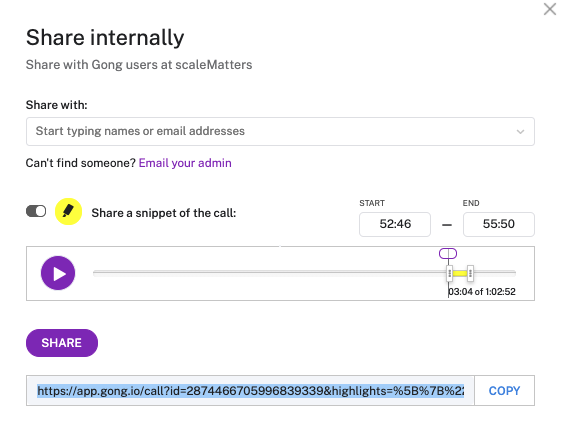
Let’s say you have a new cohort of sales people onboarding next week and you want to help them learn about how your product is solving real problems in the marketplace. How about letting your prospects do the explaining? You can gather recorded calls or call snippets and store them in call libraries in Gong based on topic. Then, you can just share access to that folder with the new hires!
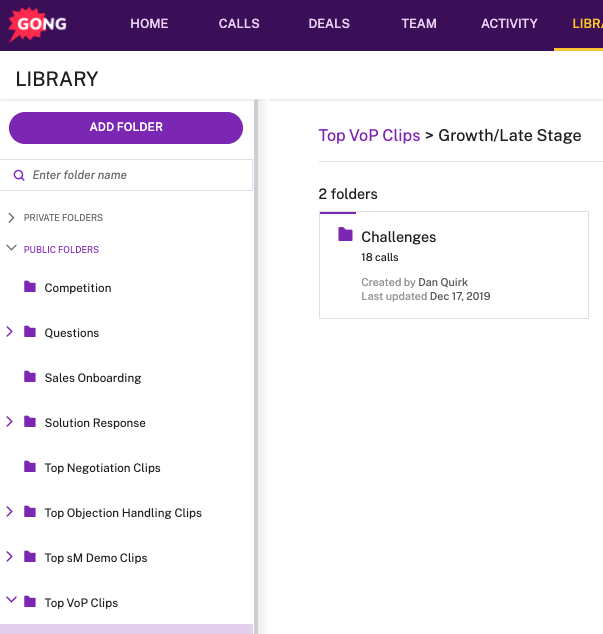
Perhaps while you’re listening to a call, you hear a prospect describe a particular feature that would make their job so much easier. You want your product managers to hear that ASAP! You can make comments, tag co-workers, and configure Gong so that anytime a certain hashtag is used, your product team is notified.
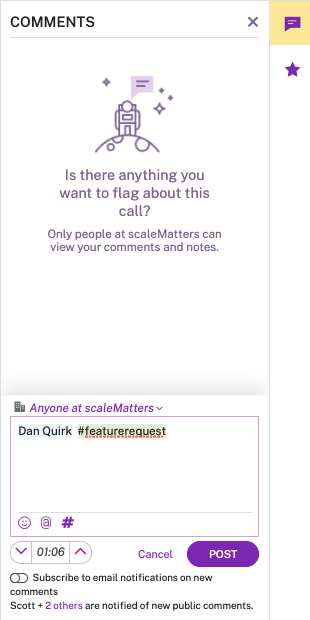
After you start capturing what your prospects are saying on Gong’s conversation intelligence tool, you’ll want to structure the data so it’s useful for optimizing marketing messaging, sales pitches, and product roadmaps.
If you think of a typical sales call, it usually involves some time for discovery about the prospect’s current situation and their goals, and then the call incorporates a presentation or demonstration of how a given solution can help solve the prospect’s challenges.
Throughout these calls, there is valuable give and take, questions and answers, and objections and counter-objections that all combine for an absolute gold mine of data.
Marketing
Sales/SDR
Product

Through our integration with Gong, scaleMatters takes Voice of Prospect data to the next level.
We synthesize Voice of Prospect data sourced from Gong with opportunity data sourced from Salesforce to surface incredible insights around buyers, competitive dynamics, feature importance, and objections.
Our insights have proven to drastically improve win rates as companies no longer rely on guesswork when it comes to their sales messaging, marketing messaging, and product roadmap priorities.
An intimate understanding of a company’s prospects’ characteristics is critical in order to optimize messaging as well as product capabilities. Prospect Profile data is generated by Gong trackers configured by scaleMatters to answer the following questions:
“What is the current state of the prospect as it relates to your company’s solutions? In other words, what is prospect currently doing (e.g. tools, strategies, techniques, etc.) to address the issues addressed by your company’s solutions?”
“What is the desired future state of the prospect? In other words, what would they like to achieve that they currently can’t, given their current state of addressing the issues addressed by the company’s solutions?”
“What are the obstacles preventing them from achieving the Desired Future State (e.g. pain points)?”
scaleMatters aggregates the frequency of each tracker as well as the comparative success at winning opportunities when a given tracker is present. This information is available across the aggregate of all customer acquisition strategies as well as for each individual strategy.
Furthermore, the scaleMatters data model accommodates the tracking of historical changes of Prospect Profile data to help revenue leaders understand if their targeting initiatives are having an impact.
A thorough understanding of your company’s competitive dynamics is critical in order to optimize competitive selling/messaging strategies as well as product capabilities. Competitive dynamics data is generated by Gong trackers configured by scaleMatters to answer the following questions:
“What competitors did the prospect mention in any context?”
“What competitors did the prospect mention they are currently using?”
“What competitors did the prospect mention they are currently evaluating?”
For each competitive Dynamics data element, the scaleMatters data model counts the portion of prospects for which the data element is present as well as the comparative success at winning opportunities when a given data element is present. This information is available across the aggregate of all sourcing strategies as well as for each sourcing strategy.
Furthermore, the scaleMatters data model accommodates the tracking of historical changes of competitive dynamics data to help revenue leaders understand if their competitive strategy, messaging, and roadmap initiatives are making an impact.
A comprehensive understanding of the product/solution features that prospects consider important is critical to hone sales messaging as well as inform product roadmap priorities. Feature Importance data is generated by Gong trackers configured by scaleMatters to answer the following question:
“What features did the prospect mention in any context?”
For each feature importance data element, the scaleMatters data model counts the portion of prospects for which the data element is present as well as the comparative success at winning opportunities when a given data element is present. This information is available across the aggregate of all sourcing strategies as well as for each sourcing strategy.
Furthermore, the scaleMatters data model accommodates the tracking of historical changes of Feature Importance data to help revenue leaders understand if their sales messaging and roadmap initiatives are making an impact.
A complete understanding of the objections raised by prospects is important to improve selling strategy, sales skills, and pricing strategies. Prospect objection data is generated by Gong trackers configured by scaleMatters to answer the following question:
“What objections did the prospect mention as a reason to not move forward in purchasing the company's offering?”
For each prospect objection data element, the scaleMatters data model counts the portion of prospects for which the data element is present as well as the comparative success at winning opportunities when a given data element is present. This is available across the aggregate of all sourcing strategies as well as for each sourcing strategy.
Furthermore, the scaleMatters data model accommodates the tracking of historical changes of prospect objection data to help revenue leaders understand if their sales strategy, sales training and pricing strategy initiatives are making an impact.
The power of Voice of Prospect data is best illustrated by a report our Insights team provided to one of our customers regarding their Facebook Ads acquisition strategy.
Using sales performance data and top of funnel cost data, we first established that the company’s strategy of lead generation through Facebook Ads along with SDR follow up and AE closing was costly and ineffective relative to their other strategies such as outbound prospecting and inbound marketing.
Facebook Ads were generating thousands of leads, but the low conversion rate combined with the resources required to close those leads into customers rendered it very inefficient.
However, we didn’t simply tell them, “This Facebook strategy isn't working for you.”
We actually dug into it to see if we could figure out why the funnel performance was so much worse.
We looked at Voice of Prospect data and were able to see some significant differences between the profile of the prospects that they were sourcing through Facebook versus through some of the more productive strategies.
Long story short, we were able to show our customer that the prospects coming through Facebook were substantially less sophisticated buyers than those who came through other marketing strategies. The sales pitch presented gave a level of sophistication that did not resonate with the Facebook prospects.
So we could have recommended them to try and improve their targeting so they attract more qualified leads. But they could also narrow the scope of the sales pitch to focus specifically on what those Facebook prospects were interested in (which happened to be a very important subset of the features that our client offered).
After making the change to their sales pitch for Facebook leads, it made a massive difference.
Their win rate increased almost overnight from six percent to 29 percent. They narrowed the scope of their pitch and simplified the product offering. The price points were reduced but their narrowed focus from the voice of prospect insights helped them turn their fewer opportunities into more than four times the bookings than they had just one month prior.
This article is for revenue leaders and RevOps people who are frustrated with the inability to get...